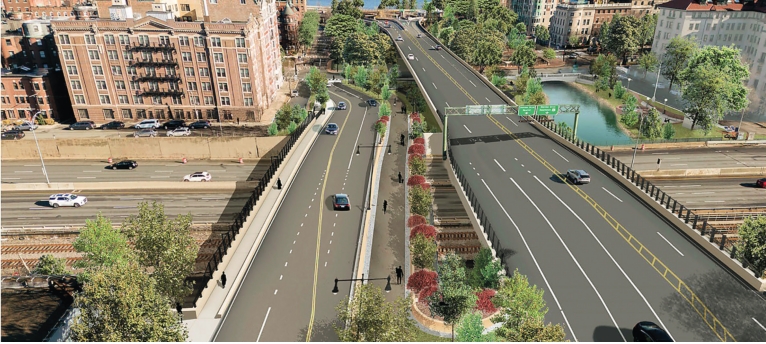
Rendering of completed Bowker OverpassState planners have finalized plans to revitalize the Bowker Overpass, the Fenway’s eastern gate, repairing crumbling road infrastructure and turning a dangerous pedestrian intersection into a multimodal paradise.
The Massachusetts Department of Transportation (MassDOT) gave the public its most complete picture yet on July 11. The public forum saw general support from residents and civic groups eager to see the broader Charlesgate project move toward fully opening that part of the Emerald Necklace.
Today, the 60-year old Bowker overpass is a knot of asphalt roads, connecting Boylston Street to Commonwealth Avenue over the I-90. Officials showed pictures of crumbling concrete and exposed rebar rusting away in the elements.
“Engineering
analysis shows the bridge superstructure warrants replacement. The
bridge is in poor condition, the I-90 overpass has been struck by over
height vehicles on several occasions. The steel has corroded severely,
the piers have deteriorated, and its service life has diminished
considerably,” said Project Manager Alwin Ramirez.
The
roadway is also hazardous for pedestrians, offering just an unprotected
concrete sidewalk directly adjacent to speeding traffic. Getting to the
other side of the overpass entails using several crosswalks in
succession at some points, and the northern gate to the Charles River
essentially cuts the Esplanade in half with a wall of seven active
roadways.
“Bicyclists
traverse on the sidewalk instead of the path, and you can see
pedestrians using sidewalks that are non-compliant with the Americans
with Disabilities Act,” said Ramirez.
New
designs aim to simplify the area for cars and increase accessibility
for pedestrians. This blueprint only covers the southern portion between
Boylston Street and Commonwealth Avenue, leaving the area even further
south to the Fenway Transportation Action Plan and the middle section to
the Charlesgate Park Revitalization Plan. The northernmost section will
require a redesign of Storrow Drive.
The
new layout will offer distinct paths for bikes, cars and pedestrians
all the way to Commonwealth Avenue from either direction, with bikes and
pedestrians sharing some parts.
The
offramps will also be redesigned, with one new road to Charlesgate west
replacing the ramps on either side to Commonwealth Avenue.
In
addition to simplifying road design and reducing the number of
crossings, this will contribute to ongoing efforts to sunlight the Muddy
River and restore it to health. Additional trees, paths and lawns in
the now-barren middle section will allow residents and visitors to stop
and enjoy the river while passing through.
Changes
to this design are unlikely at this point. MassDOT has been working on
the project since Fall 2021 and says it will have the design 100%
finished “very soon.” Once design is finished MassDOT will begin taking
bids for construction.
Construction
will take place largely at night to avoid traffic disruptions, though
at points there will be rolling roadblocks on the I-90. Ipswich Street
will see nighttime closures and parking restrictions.
Pedestrians
will be forced to one sidewalk, and cyclists will be able to use the
area as they always have, walking their bike on the sidewalk or fighting
cars for road space.
State
Representative Jay Livingstone and City Councilor Sharon Durkan did not
attend the meeting but did send staffers to speak in support, as did
State Senator Will Brownsberger.
Public
response was muted but positive, with residents hashing out details and
verifying that planners were coordinating with surrounding development
proposals like 2 Charlesgate West. The Emerald Necklace Conservancy
spoke strongly in support of the redesign.
“This
portion of the Emerald Necklace has been so compromised people don’t
even recognize it as a part of the park. This area suffers from dead
ends, lack of access. When you cross this bridge, it feels like walking
the plank,” said Conservancy President Karen Mauner-Brodek.